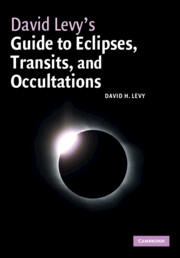Book contents
- Frontmatter
- Contents
- Introduction
- Part I The magic and history of eclipses
- Part II Observing solar eclipses
- 4 Safety considerations during a solar eclipse
- 5 What to expect during a partial eclipse of the Sun
- 6 A ring of fire
- 7 A total eclipse of the Sun: an introduction to the magic
- 8 The onset of totality
- 9 Observing a total eclipse of the Sun
- 10 Solar eclipse photography
- Part III Eclipses of the Moon
- Part IV Occultations
- Part V Transits
- Part VI My favorite eclipses
- Appendices
- A Solar and lunar eclipses due between 2010 and 2024
- B A glossary of appropriate terms
- C Resources
- Index
8 - The onset of totality
Published online by Cambridge University Press: 04 August 2010
- Frontmatter
- Contents
- Introduction
- Part I The magic and history of eclipses
- Part II Observing solar eclipses
- 4 Safety considerations during a solar eclipse
- 5 What to expect during a partial eclipse of the Sun
- 6 A ring of fire
- 7 A total eclipse of the Sun: an introduction to the magic
- 8 The onset of totality
- 9 Observing a total eclipse of the Sun
- 10 Solar eclipse photography
- Part III Eclipses of the Moon
- Part IV Occultations
- Part V Transits
- Part VI My favorite eclipses
- Appendices
- A Solar and lunar eclipses due between 2010 and 2024
- B A glossary of appropriate terms
- C Resources
- Index
Summary
In the last few minutes of a partial eclipse that will become a total eclipse, a lot of things begin to happen. The sky's gradual darkening becomes more sudden, and in the final moments the sky darkens as quickly as if someone were working a huge celestial dimmer switch. From the west, or northwest, or southwest – wherever the shadow is coming from – the sky is blackening even more rapidly. Clouds might still be visible even though there is very little sunlight left to fall on them. The Sun itself appears as a crescent so thin that it appears only as a line.
Venus appears
At almost every eclipse, between ten and seven minutes before totality begins, someone will yell a single word: “Venus!” Everyone then strains to catch a glimpse of Earth's hellish sister planet. Venus is a symbol. The sight of our neighbor world means that the sky has darkened sufficiently for the brightest planet to appear along with the crescent Sun. Along with the appearance of Venus, shadows are becoming very sharp and distinct. Just prior to totality during the eclipse of April 2005, Venus appeared due north of the Sun. The planet was near its conjunction; less than a year earlier it actually transited the Sun for the first time in more than a century.
- Type
- Chapter
- Information
- Publisher: Cambridge University PressPrint publication year: 2010

